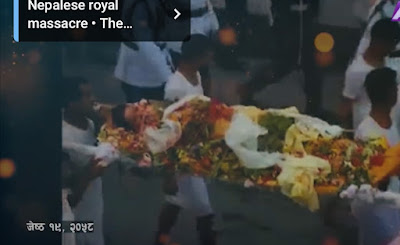Palace massacre in history, a confluence of mystery.
Today, it has been 22 years since the Darbar massacre, but this massacre is still mysterious in the eyes of the people, so here is presenting some facts about it.
On the fateful night of June 1, 2001, Nepal was shaken to its core as a horrifying event unfolded within the walls of the Narayanhiti Palace. Known as the Palace Massacre, this tragic event forever altered the course of Nepal's history, leaving the nation in a state of shock and confusion. In this article, we delve into the details surrounding the Palace Massacre, examining its causes, consequences, and the enduring legacy it has left behind.
Background:
Nepal, a landlocked country nestled in the Himalayas, had long been ruled by the Shah dynasty, which had been in power for over two centuries. King Birendra Bir Bikram Shah Dev, a highly revered figure in Nepal, had ascended to the throne in 1972 and was known for his efforts to transition the country into a constitutional monarchy.
The Palace Massacre:
On the night of June 1, 2001, a family gathering was taking place in the Narayanhiti Palace. King Birendra, Queen Aishwarya, Crown Prince Dipendra, and several other members of the royal family were present. Ten members of royal family were victims in the massacre.
In a shocking turn of events, The oficial report concluded that Crown Prince Dipendra was responsible for the massacre. According to the investigation, prince Dipendra went on a shooting spree, killing his family members before turning the gun on himself. However there have been speculations, controversies surrounding the events of the massacre.
Armed with automatic weapons, Dipendra opened fire on his family members, resulting in the deaths of King Birendra, Queen Aishwarya, and eight other close relatives. After the massacre, Dipendra turned the gun on himself, succumbing to his injuries a few days later. The incident left the nation grappling with disbelief and grief, seeking answers to the inexplicable tragedy that had unfolded.
Causes and Controversies:
The exact motives behind the Palace Massacre remain shrouded in mystery and speculation. Numerous theories have emerged, ranging from personal disputes within the royal family to political tensions and even external influences. However, the official investigation carried out by the government concluded that Dipendra was responsible for the heinous act before taking his own life. The lack of concrete evidence and transparency surrounding the investigation has fueled ongoing debates and conspiracy theories over the years.
Consequences and Impact:
The Palace Massacre had far-reaching consequences for Nepal. Crown Prince Dipendra's uncle, Prince Gyanendra, assumed the throne as the new king, becoming the last monarch of Nepal. The tragedy also fueled widespread public anger and dissatisfaction with the monarchy, leading to increased calls for democratic reforms.
In the aftermath of the massacre, Nepal witnessed significant political upheaval, ultimately resulting in the abolition of the monarchy and the establishment of a federal democratic republic in 2008. The event marked a turning point in the nation's history, symbolizing a break from centuries-old monarchical rule.
Legacy and Remembrance:
The Palace Massacre remains etched in the collective memory of the Nepalese people as a profound national tragedy. Annually on June 1, the nation mourns the loss of their beloved King Birendra and reflects on the consequences of that fateful night. The Narayanhiti Palace, witness to the unspeakable violence, was converted into a museum to preserve the history and remind future generations of the profound impact of the event.
Conclusion:
The Palace Massacre stands as a tragic chapter in Nepal's history, forever altering the nation's trajectory and leading to significant political transformations. While the exact motives behind the event may never be fully known, its consequences continue to shape Nepal's socio-political landscape to this day. The legacy of the Palace Massacre serves as a solemn reminder of the fragility of power and the need for transparent governance in any society.







Comments
Post a Comment